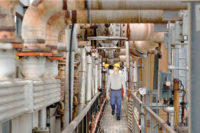Effective safety training helps eliminate the chance for incidents and accidents associated with airborne hazards in the workplace. OSHA standard 1910.134 (c) (k) details the requirements for both an effective respiratory training program and workplace safety plan.
At a minimum, a respiratory safety program should include basic information about: airborne hazards; the potential for respiratory hazards found in the workplace; and the use of respiratory PPE, usually in the form of a respirator.
Common hazards
Common respiratory hazards are typically broken down into three categories: oxygen deficiency, particulate contaminants, and gas and vapors.
An oxygen-deficient environment is most likely to occur in confined spaces such as manholes, sewers, ship holds, silos and storage tanks — just to name a few. In a matter of minutes, your judgment and muscular coordination are affected by the lack of sufficient oxygen, including your sense of balance, mental awareness and sense of direction. Long-term exposure to an oxygen-deficient environment will soon lead to unconsciousness and eventually death. One is not always immediately aware if they are in an oxygen-deficient environment. Monitoring devices should always be used to measure the oxygen level of any unknown environment.
Dust is comprised of solid particles that can range greatly in size, including those that cannot be seen with the naked eye. Mist, often generated in such operations as dipping, machining and spray-painting, contains tiny droplets of moisture formed when liquids are sprayed or mixed. Fog is a mist of sufficient concentration that it obscures vision. Fumes are tiny metallic or metal oxide particles given off when metals are heated. And smoke consists of gases, vapors, particles and liquid aerosols that are generated by burning or chemical reaction; it is often concentrated enough to obscure vision.
Personal protection
A first line of defense for respiratory safety is engineering controls. These include screens, machine guards, vents and filters. Air quality monitors, which can detect the presence of hazardous gases and also warn of an oxygen-deficient environment, are also needed.However, no system is foolproof, and individual respiratory protection is often required to ensure the safety of workers.
A foundational aspect of any respiratory protection plan is a respirator.
Respirators are divided into two basic categories: air-purifying and air-supplying. Air-purifying respirators clean contaminated air by removing hazards when air is passed through an air-purifying element. Air-supplying respirators supply breathable air from a source that is different than the contaminated air.
The type of respirator used is determined by the specific set of hazards a worker may encounter as well as the task to be performed. Basic respirator configurations include tight-fitting respirator pieces, such as half-masks and full-facepieces, as well as loose-fitting respirator pieces such as hoods and helmets. Establishing a proper fit for the respirator is also essential for worker safety.
Well written
OSHA requires employers to develop and implement a written respiratory protection program with worksite-specific procedures and elements for required respirator use. A suitably trained program administrator must administer the program. In addition, certain program elements may be required for voluntary use to prevent potential hazards associated with the use of the respirator.
Putting a respirator program in writing entails significant pre-planning for the implementation steps of the program. These steps include selection, medical fitness, maintenance, training, fit testing, use and ongoing program evaluation.
SIDEBAR: The right fit
There are two types of respirator fit testing: qualitative and quantitative.During a qualitative fit test the wearer is exposed to a test agent such as an odorous chemical or an irritant smoke. If the wearer smells the odor or experiences irritation of the nose or throat, that particular respirator fails the test.
For a quantitative fit test the respirator is fitted with a special probe. A tube connects it to an instrument that measures the air outside the facepiece versus inside. If leakage exceeds specifications, the respirator fails the test.
During both the quantitative and qualitative fit tests the respirator wearer should perform a number of exercises, including talking, to simulate all possible situations that could be encountered on the job.



